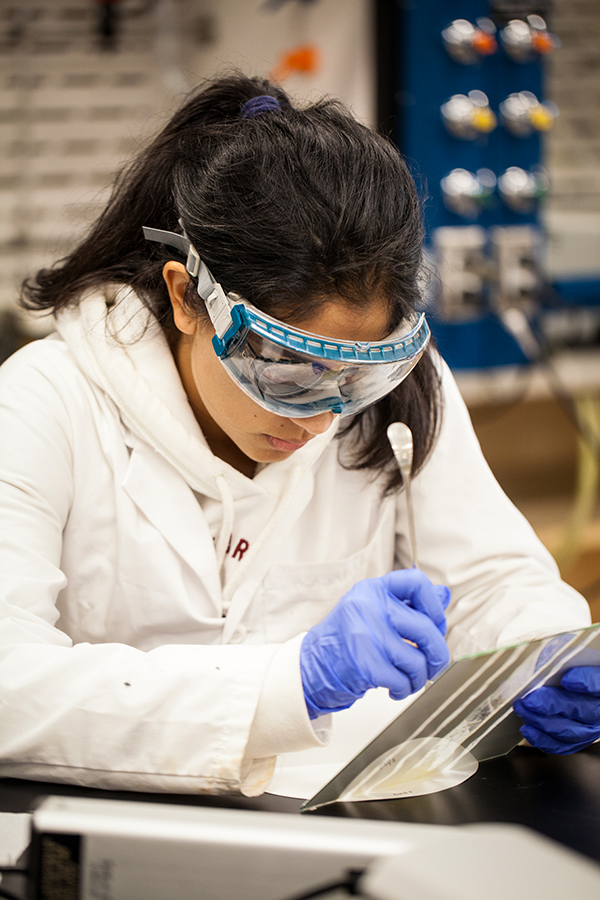 A $1.5 million grant from the National Science Foundation is meant to develop new information that further boosts the University's ability to educate and put into the workforce graduates with high skill levels in several important disciplines. (Sacramento State/Andrea Price)
A $1.5 million grant from the National Science Foundation is meant to develop new information that further boosts the University's ability to educate and put into the workforce graduates with high skill levels in several important disciplines. (Sacramento State/Andrea Price)Sacramento State has won significant seed money in its effort to grow STEM programs.
The University has been awarded a five-year, $1.5 million grant by the National Science Foundation (NSF) as part of the latter’s Improving Undergraduate STEM Education: Hispanic-Serving Institutions Program (HSI Program). Sacramento State professors Lynn Tashiro (Center for Teaching and Learning) and Mary McCarthy-Hintz (Chemistry) are co-principal investigators on the grant proposal, Building Capacity: STEM Faculty Professional Learning in the Zone of Proximal Development. Di Xu, a professor of education at UC Irvine, also is a co-principal investigator.
STEM programs are those associated with science, technology, engineering and mathematics.
The project seeks to build institutional capacity for improving undergraduate STEM teaching and learning. It will support efforts to improve the teaching effectiveness of STEM faculty and to advance knowledge about strategies that lead to increased use of evidence-based and equity-minded teaching strategies.
Sac State is among the first 31 colleges and universities to receive awards for NSF’s HSI program, funding 31 projects and totaling approximately $45 million. The grant runs Oct. 1, 2018, to Sept. 30, 2023.
Using online, hybrid, and face-to-face training formats, the project will provide customized professional learning programs to help STEM faculty improve their teaching. The training also will help inrease faculty awareness of the roles played by diversity, intercultural competence and critical consciousness in students’ development and persistence, including those who are underrepresented in STEM.
The faculty learning programs will be designed to meet faculty where they are in their professional career and in their understanding of equitable classroom practices. Investigators estimated that the project will help approximately 125 faculty implement evidence-based and equity-minded teaching strategies, potentially improving the learning of more than 37,000 science and math undergraduate students, as well as to broaden the participation and success of students underrepresented in STEM.
“Many of our students possess different skills, values, and backgrounds than most STEM faculty had when we were students,” McCarthy-Hintz and Tashiro said in a statement. “This project gives our STEM faculty a venue to explore how to build on these differences to enhance student learning.
They said that the curriculum will be tailored to each faculty member’s needs, regardless of their level of how long they've been teaching.
"Faculty participants will develop their teaching skills by identifying specific areas in which they want to improve," McCarthy-Hintz and Tashiro said in the statement. "We expect that this will lead to increased persistence of students in STEM fields, particularly of students from underrepresented groups.”
McCarthy-Hintz says study results will be published at the end of the five-year project, but that a change in student grades is expected by the end of the second year and that she and Tashiro will help faculty track and document changes in their own courses.
Hispanics constitute 16 percent of the U.S. workforce but make up only 6 percent of the country's STEM workforce. More than 60 percent of Hispanic students attend an HSI. The study also aims to build capacity at HSIs with little or no prior NSF funding. Of the initial 31 projects, NSF issued awards to five such community colleges and three universities.
Congresswoman Doris Matsui, a longtime advocate of STEM education, acknowledged the importance of the grant and the benefits that could result from it.
“This NSF STEM grant for Hispanic-Serving Institutions will help support Sacramento State’s ongoing work to bolster teaching in the STEM fields and learning in our community,” Matsui said. “I applaud Sacramento State for their continued commitment to expanding the horizons of their students.” – Ahmed V. Ortiz
